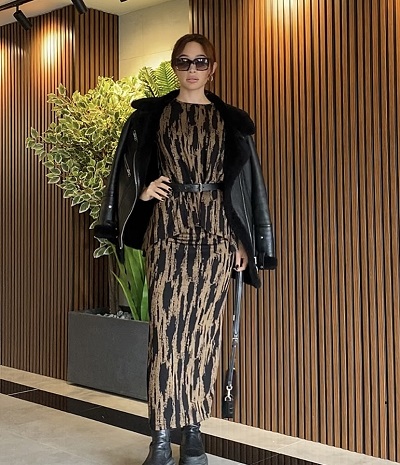
by Kosher Casual Team | Jan 12, 2025 | Long Skirts, maxi skirts, Modest Skirts, Winter Layering, Women's Maxi Pencil Skirts
When it comes to style, from winter to summer we all know women’s pencil skirts are going to be in style every. single. year. One of the quickest, easiest and most affordable ways to stay warm up is with maxi pencil skirts. Not just any pencil skirts though – we’re talking about soft, stretchy long skirts that keep you warm and flatter your shape at the same time.
Pencil skirts are an effortless item of women’s clothing that can be styled throughout warm and cold weather as well as day to night. Here are some styling ideas while keeping your unique and modest fashion sense in mind:
Stretch Fabrics:
Long modest pencil skirts are tricky! Fabrics with spandex or lycra will allow greater freedom of movement without openings or slits. For colder weather, heavier weight cotton or wool blends work great! For warm weather, natural breathable viscose or any structured and stretchy opaque material is ideal.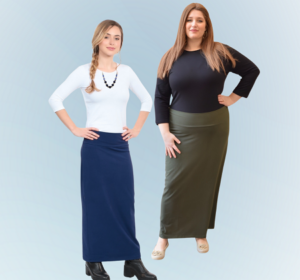
Layering for Interest – Leggings and Tights
Avoid pencil skirts with slits and add tights for comfort, texture and modesty
Wearing leggings or tights under the skirt can add comfort and warmth while staying true to your style.
For a streamlined look, wear a matching color for a monochromatic color scheme textured or ribbed tight to add subtle interest.
Balanced Proportions
Since a maxi pencil skirt is sleek and fitted, pair it with a slightly looser top to balance the silhouette:
Elbow-Length sweater: opt for a lightweight knit in neutral tones to match your minimal aesthetic.
For work: choose a Choose a tailored shirt in soft fabrics, tucked in or tied at the waist
In casual settings a tunic either semi-fitted or loose keeping it easy and comfortable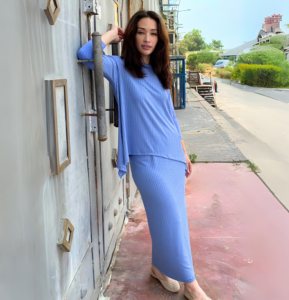
Footwear Pairings
Stay true to your love of sneakers, boot or sandals and modest dressing:
Sleek sneakers: clean white or neutral sneakers keep the look casual yet fun and polished.
Gladiator sandals or minimalist ankle-strap sandals work particularly well with the pencil skirt’s clean lines. Block or kitten heel shoes add a touch of sophistication – perfect for the office or dinner.
Keep Accessories Simple
A small cross body in neutral leather or canvas bag completes the outfit without overwhelming it.
Shorter necklaces complement women’s maxi skirts without “cropping” the silhouette.
Small hoops or drop earrings in geometric shapes, in gold or silver add an artistic touch without over-accessorizing.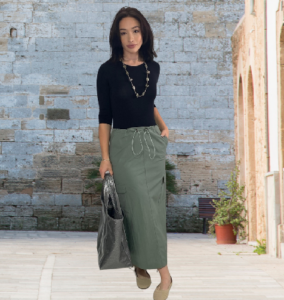
While classic, the pencil skirt can feel modern and on-trend with updated details like drawstring waists, textured fabrics or asymmetrical hems. They provide full coverage, which makes them a favorite for those seeking modest yet stylish options. The length and fit strike a balance between demure and chic, and transition easily from casual to formal settings.
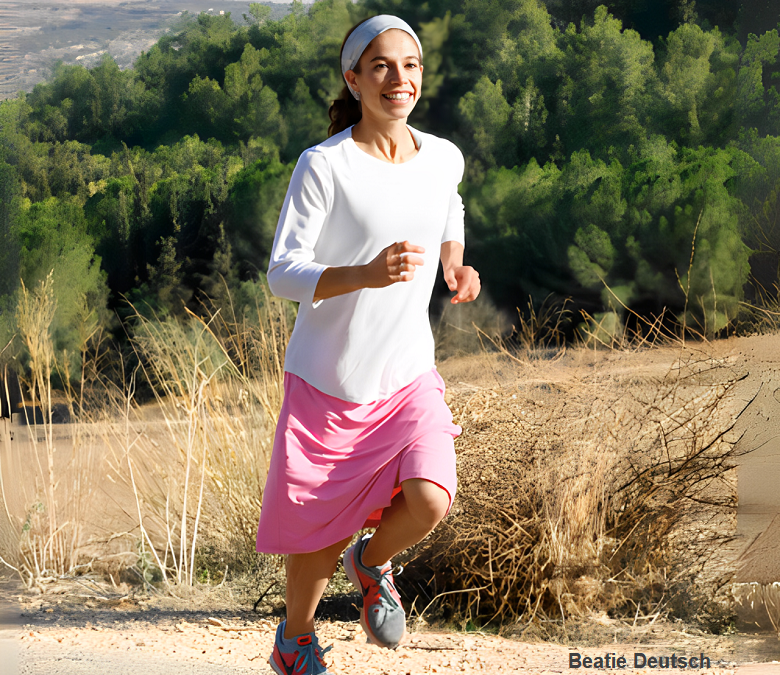
by Kosher Casual Team | Sep 22, 2024 | modest clothing, Religious Modesty standards, Running Skirts, Sports Skirt, workout clothing
Modest Skirt Wearers Can Run Fast!!!
Can I run in a skirt? Absolutely, you can run in a skirt! Many people find it comfortable and stylish. Just make sure it’s a design that allows for movement, like a skort or a running skirt with built-in shorts. It’s all about what makes you feel good while you run! Modest running skirts offer several advantages for those who prefer a more covered style while staying active. Those who prioritize modesty for personal, cultural and religious reasons can still fully enjoy exercise, outdoor recreation or leisure activities.
Several famous female runners have worn skirts during races, either for comfort, style, or sponsorship reasons. Some of them include:
Deena Kastor, Shalane Flanagan and Joan Benoit Samuelson long distance runners and Olympic medalists- have all trained and worn running skirts in races. Beatie Deutsch is an American-Israeli marathon runner who lives in Israel. An Orthodox Jewish mother of five, she only wears sport skirts with leggings or shorts. She has competed in marathons all over Israel and in Berlin, Germany, Tokyo, Japan, Seville, Spain and Cape Town, South Africa often winning first or second place!
How to Select Great Running Skirts
Skirt Design
Look for skirts specifically designed for athletic activities and cuts that allow for a full range of motion.
Choose a skirt length that doesn’t impede your stride, knee-length or slightly above can be ideal. Ensure the fit is not too tight around the hips and thighs to allow for easy movement. Select a length that you find comfortable and that provides adequate coverage for your activity. Find a style that’s versatile! A skirt suitable for running and can be worn during the day with a t-shirt as well as by night with a blouse.
Fabrics
Many sport skirts now are made with moisture-wicking fabric – keeping you dry and comfortable by drawing sweat away from the skin. Some have mesh panels or vents that enhance airflow and prevents chafing.
Four-way stretch fabric offers maximum stretch and durability and will withstand the rigors of training and racing. Another great feature is fabrics that offer UVF protection from the sun. Fabrics should be lightweight and but also opaque (not see through), there are also heavier weight fabrics for fall and winter.
Features
Pockets, who doesn’t love pockets! Who wants to carry a purse? Deep pockets with zippers that have enough room for a cell phone or keys are essential. Another great feature in sport skirts are adjustable waistbands either stretch elastic waistbands or drawstring.
Sport/Swim Skirts should be made for with double stitched seams and hems to be resilient on concrete, hard ground and a range of activities and travel. For early morning or evening runs clothing with reflective elements for safety and visibility is essential. Finally for marathon runners, test your skirt with a shorter run or jog to ensure it’s comfortable and doesn’t cause any issues before running.
Yes, modest skirt wearers can run fast, but there are some aspects to consider to ensure comfort and safety. Many brands offer a variety of styles and fits to cater to different preferences and needs.
What do you want in a running skirt?

by Kosher Casual Team | Sep 18, 2024 | Dress Code, Dress Code, Girls Knee Length Skirts
Are School Dress Codes Modest?
School dress codes vary widely depending on the institution and its location, so the level of modesty can differ significantly. Dress codes are designed to maintain a sense of decorum and reduce distractions in the learning environment. Common religious school guidelines often include:
- Jewish schools might have guidelines that align with tzniut, which typically includes long skirts, sleeves covering the elbows, and avoiding see through blouses or shirts.
- Christian schools might require skirts or dresses for girls, often knee-length or longer, and may prohibit certain types of clothing like sleeveless tops, tight-fitting clothes, or anything deemed too revealing.
- Muslim schools might require hijab for girls, along with loose-fitting clothing that covers the arms and legs.
- Sometimes mandating specific types of clothing, like uniforms, which can inherently be more modest.
- Some dress codes aim for practicality and safety rather than modesty, like requiring closed-toe shoes or banning certain types of jewelry.
While these dress codes are designed to meet the standards of modesty within the school’s religious framework, opinions on what is considered “modest enough” can still vary. Some might find these dress codes perfectly aligned with their values, while others might feel they are either too strict or not strict enough, depending on their personal or community standards.
- Prohibiting clothing that reveals too much skin, such as crop tops, short shorts, and low-cut tops.
- Requiring skirts and shorts to be a certain length, usually no shorter than mid-thigh.
- Banning clothing with offensive or inappropriate graphics or language.
- Prohibited items: Some schools ban clothing with offensive language, images, or references to drugs, alcohol, or violence.
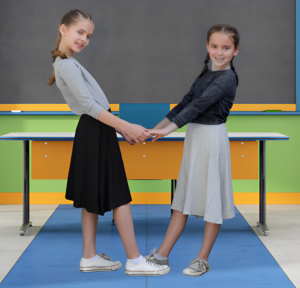
Secular School dress codes in the USA vary widely by district, school, and sometimes even by grade. While there is no standard dress code that applies to all schools, many do have policies intended to promote a level of appropriateness in the school environment. These often include parameters such as:
- No revealing clothing: This can include prohibitions on items like crop tops, short shorts, low-cut tops, and skirts or dresses that are too short (often defined as needing to be fingertip length or longer).
- No visible underwear: Students are usually required to ensure that their underwear is not visible, which means sagging pants or very low-rise jeans may be prohibited.
- Appropriate coverage: Shirts typically need to cover the midriff, and tank tops often need to have straps of a certain width (e.g., no spaghetti straps).
Challenges and Controversies
- Student Expression: Some argue that strict dress codes limit students’ ability to express their individuality.
- Fashion Trends: Fashion trends can influence how students wear their uniforms, sometimes leading to modifications that result in shorter skirts.
- Gender Disparity: Many dress codes are criticized for being more restrictive toward female students. Rules often focus on covering shoulders, legs, and cleavage, while similar restrictions aren’t always applied to male students.
School dress codes generally aim to be modest, but whether they succeed depends on cultural norms, personal beliefs and values. There is an evolving debate about what should be considered modest and how strictly school dress codes should be implemented. Using these guidelines, schools and families can create a dress code that is fair, respectful, and accommodating and strike a healthy balance between fashion and modesty.

by Kosher Casual Team | Jul 14, 2024 | modest clothing, Modest Dresses, Modest Fashion, Religious Modesty standards
How to Teach Girls to Dress Modestly!Teaching girls make clothing choices that are respectful, appropriate for various settings, and aligned with societal values in today’s world is not always easy. We want to prepare our children for a world where external appearances can influence perceptions. Here are some strategies for teaching girls to dress modestly:
Start Early: Begin teaching girls about appropriate clothing choices from a young age. Even children as young as three can understand simple concepts as they learn to dress themselves.
Explain the Reasons: Help girls understand why the way we dress is important and how it contributes to their self-respect, dignity, and relationships with others. Talk about how your religious beliefs, culture, environment and values. It is crucial in navigating these discussions to foster open and honest communication.
Set Clear Guidelines: Establish clear guidelines for appropriate attire in different settings, such as at home, school, religious gatherings, and social events. Offer them guidance on selecting clothing items that provide adequate coverage and are respectful of their bodies.
Encourage Self-Expression: Allow girls to express their personal style and preferences within the boundaries of what’s acceptable. Encourage them to choose clothing that reflects their individuality while also respecting cultural norms and social expectations.
Teach Dress Codes: Familiarize girls with dress codes at their school, religious institution, or other places they frequent. Help them understand the reasons behind these dress codes and how to comply with them while still expressing some individuality.
Provide Feedback: Offer constructive feedback and guidance when girls are selecting clothing or putting together outfits. Encourage them to consider factors such as fit, length, shirt necklines, and overall coverage when making clothing choices. 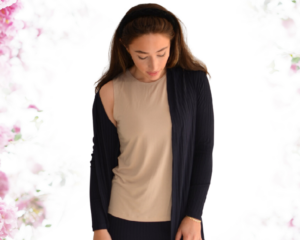
Be a Role Model: Lead by example with your own clothing choices and behavior. Girls often learn from their mothers. Teach your daughters to dress with confidence and self-assurance.
Discuss Media Influence: Talk to girls about the influence of media, fashion trends, and peer pressure on clothing choices. Help them develop critical thinking skills to navigate messages about beauty, body image and self-worth in the media.
By incorporating these strategies into your parenting approach, you can help girls develop a sense of modesty and make respectful clothing choices that reflect their values, individuality, and self-respect.

by Kosher Casual Team | Jun 1, 2024 | Modest Plus Size, Plus Size
Ten Myths of Modest Plus Size Dressing!
Dressing modestly and feeling confident in your clothes is important for everyone, regardless of size. Here are some tips specifically for plus-size women to dispel some common myths and help you feel your best. Plus-size women can dress stylishly, modestly and still look fabulous!
Myth: Modest clothing means wearing baggy, shapeless outfits.
Modest clothing can be stylish and flattering. Tailored pieces, wrap dresses, and structured garments can provide a polished look while maintaining modesty.
Myth: Dark colors are the only slimming option.
Don’t shy away from bright colors or prints! Choose ones that make you feel vibrant and confident. Avoid Big loud prints and choose smaller prints patterns. While dark colors can be slimming, so can well-fitted clothes in lighter shades.
Myth: Plus-size women should avoid prints and patterns.
Prints and patterns can be very flattering. The key is choosing the right size and placement of the pattern. Larger prints can work well, and patterns can be used to highlight or downplay certain areas.
Myth: Modest dressing for plus sizes means long skirts and high-necked tops only.
Modesty is about coverage, not necessarily specific trend or styles. You can wear knee length or midi skirts, high-waisted pants, or tops with interesting details like embroidery, raw edging or reverse seaming and work well for even the curviest woman.
Myth: Plus-size women can’t wear trendy clothes.
Plus-size women can embrace fashion just like anyone else. Many brands offer trendy, plus-size options that are also modest. Don’t feel restricted by fashion rules. Adapt trends to suit your style and comfort level.

OLYMPUS DIGITAL CAMERA
Myth: Layering adds bulk and makes plus-size women look bigger.
Smart layering can actually enhance your look. Using layers adds depth to your outfits. Long cardigans, blazers, and duster coats can add structure and length to your ensemble.
Myth: Belts and waist-defining garments are not for plus-size women.
Belts and waist-defining garments can be very flattering. They can highlight your curves and create a balanced silhouette. Ideally, belts should be worn empire style (under the bust) or at the natural waist.
Myth: Plus-size women should avoid clingy fabrics.
The fit and cut of the clothing are more important than the fabric. Close fitting fabrics can look beautiful on plus-size women with the linings and tailoring. Even affordable clothes can look high-end when they fit perfectly.
Myth: Modest plus-size fashion is limited and hard to find.
There are many brands and designers now catering to plus-size, modest fashion. Online shopping has also made it easier to find a wide variety of options. Read reviews and view actual plus size women wearing the clothing to get a good idea of the fit.
Myth: Plus-size women can’t wear fitted clothes.
Embrace your curves! Fitted clothes can look very elegant on plus-size women. The key is ensuring garments are sized right, wearing comfortable shapewear and avoiding skin-tight fabrics.
By understanding and debunking these myths, plus-size women can embrace modest fashion that makes them feel vibrant, confident and stylish. Fashion is personal, and the most important thing is to wear what makes you feel comfortable and happy.












